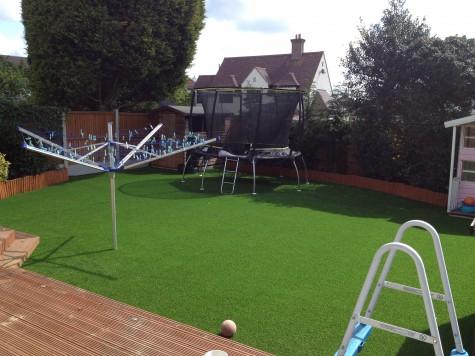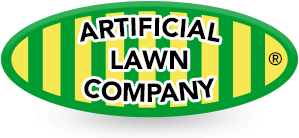
Artificial lawns can last for a long time, typically up to 12-15 years! They will stand up to the fiercest weather conditions and tremendous wear and tear. To ensure your lawn survives though, it is important that you first take proper care of your investment.
Artificial lawns can last for a long time, typically up to 12-15 years! Even after this point they will still be green and looking great just might be a little tired and flat (similar to indoor carpets). They will stand up to the fiercest weather conditions and tremendous wear and tear. To ensure your lawn survives, though, it is important that you first take proper care of your investment.
One of the biggest advantages of artificial grass is how little maintenance is needed to keep it in good condition - especially when compared to natural grass, which will need everything from water to weed killer. That being said, there are a few things you can do to add extra longevity to your new lawn as nothing is truly zero maintenance.
Although you can happily wave goodbye to monotonous mowing and wearisome watering, there are some small maintenance tasks which will need to be completed, such as cleaning artificial grass. Just a little bit of care will leave your lawn glowing! That said, how do you clean fake turf?
What’s the Best Way to Clean Artificial Grass?
The best way to clean fake grass is largely dependent on what needs cleaning up. For example, how you would clean up after your pet would differ from how you would clear away discarded chewing gum.
Using the wrong materials and products to clean your artificial grass can result in damaging the turf, aesthetically or in its functionality in terms of its drainage system – or both. Here, Artificial Lawn Company details exactly how you should care for and clean your fake lawn.
Large Debris
Branches, twigs, odds and ends of rubbish - while most people remember to pick up and remove big bits of rubbish from their lawn - whether natural or artificial - it's a good habit to get into as it's an easy way to improve the look of your garden in no time at all!
Small Debris
Since leaves, seeds from nearby trees, and other small-scale biological detritus can break down into your fake grass; it is best to remove and clear the lawn as often as you can. The best tool for this tends to be a normal garden broom, stiffer the better to sweep and clear the lawn. Leaf blowers or even small power brushes can also make this even easier. A broom or power brush however does also help lift the pile of the lawn and keep it upright which extends the lifespan of the lawn and prevents it from going flat; similarly to the effect of hoovering an indoor carpet to get it plush.
Pet Problems
While your garden might lack any fire hydrants, lamp posts, or the other go-to objects of fascination that our four-legged friends usually choose as a toilet on the go, this doesn’t mean that they will refrain from conducting business on your nice new artificial lawn. While some pet owners set aside specific gravel or a soiled area to act as an outdoor litter box for their pets to use, not all pets are as amenable. Worry not, pet lovers! There are ways in which you can quickly get your synthetic lawn looking its best again:
- Solids are easily managed by responsible pet owners with a well-placed bag and scoop, much like when you take your pooch for walks or would clear up after them on a natural lawn.
- For liquid waste, it's advisable to rinse the area with water to help drainage and drain the urine from the surface of the lawn down into the subbase. This is not really required in the wetter months but can help in the summer. This is particularly important if you have multiple dogs or if they like to use the same spot repeatedly. We would recommend giving any dog lawn a good rinse before any special events, such as a family BBQ or party, especially during the warmer months, to remove any urine from the surface of the lawn area. Enzymatic and kennel cleaners can be used if you’re starting to experience any buildup of smell.
Snow and Ice
When it comes to clearing snow, the easiest thing to do is to wait and let it naturally drain away. However, if you should need to remove the snow from your artificial lawn, make sure to take care. Shovels (or anything metal) should be avoided, as slamming a sharp-edged tool down into your artificial grass could cause damage. Only use a shovel to clear upper levels of thick snow and clear the rest using a stiff, non-metal bristled broom. A plastic snow shovel is the ideal solution, as this won’t damage the grass when used correctly. We would also recommend against using salt to prevent ice from forming, as the salt residue can build up and block drainage.
Food and Drink Spills
In most cases, the broom/rinse combo will deal with the more common problems linked to spillages of food or drink. Don’t try using harsh chemicals or cleaning agents, as they aren’t necessary and could bleach or otherwise damage your artificial lawn. Chewing gum has, on occasion, been noticed as a more stubborn customer. A plastic putty knife may be useful, or an ice cube to chill the gum and let it slip loose that way.
Can You Hoover Artificial Grass?
One question that we get asked every now and then by our customers is ‘Can I hoover artificial grass?’ – the answer is no in most cases. You should refrain from using a vacuum cleaner on your synthetic turf, as the suction will remove the infill sand from the grass area. Equally, any rainfall and/or condensation can damage your vacuum if it is not designed to clean damp surfaces.
For the cleaning of artificial grass, brushing with a stiff-bristled broom is always best, as it can get your artificial grass looking its best in no time at all. It is most effective when brushed against the pile direction of the grass to try and stand it upright as best as possible. If you have a particularly large grass area, a power brush (either electric or petrol) could be handy and much quicker than a normal broom. Other than that, keep your lawn free of debris and enjoy all your time saved!
If you have an artificial grass cleaning query not answered above, head over to our helpful FAQ page that covers the most common customer queries, such as how to clean synthetic grass and more. Otherwise, you can reach out to our team directly by calling 01474 364320 or emailing us via the contact page.
